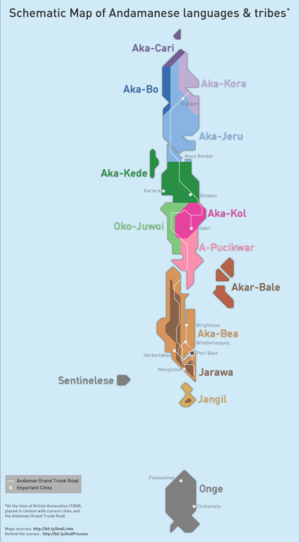加洛瓦语(Järawa、Jarwa)是一种翁奇语系语言,由加洛瓦人使用,分布在拉特兰岛内部及中南部、南安达曼岛中部内陆及南部内陆、中安达曼岛西海岸。[4]
Järawa在阿卡-比语中意为“外国人”,是他们传统敌人的语言。与世界上许多民族相仿,他们自称为“人民”aong.
加洛瓦语主要由生活在安达曼-尼科巴群岛西海岸的狩猎采集人群使用。[4]
加洛瓦人是安达曼群岛中仅存的尼格利陀人残余。他们不仅是传统的渔猎者,还被誉为勇士与不屈的领土捍卫者。加洛瓦人作为部落实体,在遭受外来疾病的袭扰后仍然存在。[5]
加洛瓦人目前剩下约270人,他们面临的主要威胁是安达曼干线公路,穿过他们的领地和1028 km2的常绿林保护区。[6]
加洛瓦人的祖先被认为是首次迁出非洲的人类的后代。如今,安达曼群岛上仍维持着多样性,岛上居住着数十万印度移民。[6]
加洛瓦语有两种方言,分别分布在中安达曼岛北部和中安达曼岛南部。[7]
加洛瓦语有28个辅音和13个元音。[4]加洛瓦语、翁奇语,可能还有哨兵岛语都从原始翁奇语分化而来,因此在文化和语言上有相似特征。[8]
加洛瓦语元音有圆唇不圆唇和长短之分,可分为3组:
- 前元音 - [i]、[e]
- 后元音 - [u]、[o]
- 央元音 - [ɘ]、[ə]、[a]
半低元音[ɛ]、[ɔ]的音系地位不明,极为少见。[4]
词首的/p/>/b/正在发生(注意翁奇语没有/p/)。[9]
加洛瓦语词汇至少1音节,实词至少2音节。[9]
/c/在派生环境,在元音间会浊化;/ə/后跨语素接元音会删略;/ə/的下一个音节有圆唇元音时会变成[o];在快速言语中整个音节可能删除。[9]
加洛瓦语有前后缀。前缀有两种:
- 动词、形容词、名词的代词性前缀
- 表示定义或定指性的前缀,仅用于动词
后缀的目的是:加在名词上表复数;加在动词上表语气、情态与有证性;加在形容词上表状态或有证性。[4]
加洛瓦语中,语素可以使独立存在的自由词根,如/napo/“鱼”;也可以是与强制性前缀共现的有界词根,如/ən-oɖə/“头发”。/ən-ətəhə/“坐”这样的动词也可以是有界词根。“头发”之类名词性词根和“坐”之类动词性词根若主体是人,就不能独立出现。有界词根须以某种语素为前缀。[4]
加洛瓦语有6种词性:
名词、动词、形容词与副词是开放词类,名词和动词比较丰富,形容词和副词数量较少。后置介词和代词是封闭词类,数量较少。各类词的数量递增顺序:后置介词、代词、副词、形容词、动词、名词。
代词有3种:人称代词、指示代词与疑问代词。人称代词的第一人称为'mi',第二人称为'ŋi ~ ni ~ ən',第三人称为'ħi ~ əħi'。[4]
加洛瓦语有两种不同的从句结构:无动词从句,当中以名词或形容词作为谓语的首部;以及动词从句,以动词作为谓语的首部,并带有核心论元。两种从句都有不同的形态与句法结构。[4]
一般疑问句以ka开头。结构为:ka + [主语] + [宾语] + [动词]。
/Onəħə-le/可以表示“正在做什么”或“为什么”,/ŋi onəħə-le/“你在做什么”,以及/ŋi onəħə-le ɖ-iche/“你为什么这么做”。[4]
加洛瓦语没有书写系统。在观察到的图案中,波浪线代表大海,只能通过绘画或图片进行交流。[5]迈索尔CIIL为加洛瓦语引入了修订的天城文和拉丁字母以书写。[10][11]
更多信息 词义, 发音 ...
加洛瓦语常用词句
| 词义 |
发音
|
| 黑 |
/ħiɽu/
|
| 热 |
/ħulu/
|
| 回家 |
/unnə/
|
| 月 |
/tape/
|
| 好 |
/tapo/
|
| 蛇 |
/topo/
|
| 水源 |
/ħʷawə/
|
| 野猪 |
/ħʷəwə/
|
| 我(们)在走 |
/mi bəɘʈʰe-jə/
|
| 我(们)睡觉 |
/mi omoħə/
|
| 我看见你了 |
/mi ŋ-əjojəba/
|
关闭
更多信息 词义, 发音 ...
加洛瓦语亲属词
| 词义 |
发音
|
| 父 |
/ummə/
|
| 母 |
/kaja/
|
| 丈夫 |
/a:gi/
|
| 妻子 |
/əŋa:p/
|
| 姐姐 |
/a:mi/
|
| 哥哥 |
/a:pə/
|
| 子女 |
/ajə/
|
| 弟弟/妹妹 |
/aikʰwaʈə/
|
关闭
Hammarström, Harald; Forkel, Robert; Haspelmath, Martin; Bank, Sebastian (编). Jarawa (India). Glottolog 2.7. Jena: Max Planck Institute for the Science of Human History. 2016. Zide, Norman; Pandya, Vishvajit. A Bibliographical Introduction to Andamanese Linguistics. Journal of the American Oriental Society. October 1989, 109 (4): 639–651. JSTOR 604090. doi:10.2307/604090.
- Blevins, Juliette, A Long Lost Sister of Proto-Austronesian? Proto-Ongan, Mother of Jarawa and Onge of the Andaman Islands, Oceanic Linguistics, 2007, 46 (1): 154–198, S2CID 143141296, doi:10.1353/ol.2007.0015
- Kumar, Pramod. Descriptive and typological study of Jarawa (学位论文). 2012 [2023-11-30]. S2CID 60302041. (原始内容存档于2023-02-12).
- "Jarawa." Database for Indigenous Cultural Evolution. 1-8. Web.
- Conant, Francis P. Jarawa Kin Systems of Reference and Address: A Componential Comparison. Anthropological Linguistics. 1961, 3 (2): 19–33. JSTOR 30022298.
- Sreenathan, M.; Rao, V. R.; Bednarik, R. G. Palaeolithic Cognitive Inheritance in Aesthetic Behavior of the Jarawas of the Andaman Islands. Anthropos. 2008, 103 (2): 367–392. JSTOR 40467418. doi:10.5771/0257-9774-2008-2-367.
- Zide, Norman; Pandya, Vishvajit. A Bibliographical Introduction to Andamanese Linguistics. Journal of the American Oriental Society. October 1989, 109 (4): 639–651. JSTOR 604090. doi:10.2307/604090.
- Sarkar, S. S. The Jarawa of the Andaman Islands. Anthropos. 1962, 57 (3/6): 670–677. JSTOR 40455833.
- Abbi, A. (2013). A Grammar of the Great Andamanese Language: An Ethnolinguistic Study.
- Earl, George Windsor. 1853. The Native Races of the Indian Archipelago: The Papuans. (The Ethnographical Library, I.) London: Hippolyte Bailliere. 140pp.
- William Marsden. 1834. On the Polynesian, or East-Insular languages. In Miscellaneous Works, 1-117. London: Parbury, Allen and Co.
- Sreenathan, M. 2001. The Jarawas: Language and Culture. Calcutta: Anthropological Survey of India, Government of India. 108pp.
- R. Senkuttuvan. 2000. The Language of the Jarawa (Phonology). Calcutta: Anthropological Survey of India, Government of India. iv+56pp.
- Richard C. Temple. 1903. Languages. In The Andaman and Nicobar Islands, 96-138. Calcutta: Superintendent of Government Press.
- Nair, V. S. 1979. A note on the language of Jarawas. Bulletin of the Anthropological Survey of India 28. 17-38.
- R. S. Mann. 1973. Jarawas of Andaman - An analysis of hostility. Man in India 53. 201-220.
- Cipriani, Lidio. 1959. The Jarawa Problem. Bulletin of the Bihar Tribal Research Institute, Ranchi 1. 43-55.
- R. H. Colebrooke. 1795. On the Andaman Islands. Asiatick Researches 4. 385-395.
- P. C. Coomar. 1994. Jarawa. In T. N. Pandit and B. N. Sarkar (eds.), Andaman and Nicobar Islands, 81-86. Madras: Anthropological Survey of India.


